Effect of Generator Rotor Radial Deviation on the Unbalanced Magnetic Pull of 1000 MW Hydro-Generator Unit
Abstract
1. Introduction
2. Theoretical Calculation
2.1. Transient Electromagnetic Calculation
2.2. UMP Calculation
3. FE Model for UMP Computation
3.1. The Basic Model of the Hydropower Generator
3.2. The Model of Rotor Eccentricity
4. The Results of Electromagnetic Simulations
4.1. Flux Density in the Air-Gap
4.2. Electromagnetic Force Density in the Air-Gap
4.3. The Influence of Different Eccentricity of Rotor
- Firstly, the harmonic component of the electromagnetic force is smaller compared to the DC component, and the difference between them is one order of magnitude.
- Secondly, both the DC component and the key harmonic component of the unbalanced magnetic pull increase with the increase of the eccentricity value, and this variation relationship is nearly linear.
5. Conclusions
- Both the space and time distributions of UMP will be changed by the elliptical deformation. The spatial distribution is related to the pole and stator tooth core distribution. And the frequency distribution is related to rotor speed and tooth slots.
- As the eccentricity increases, the stator–rotor air-gap becomes more uneven. It affects the magnetic density distribution, which in turn leads to a change in the unbalanced magnetic pull spectrum. The general rule is that both the DC component and the key harmonic component of the unbalanced magnetic pull increase with the increase of the eccentricity value, and this variation relationship is nearly linear.
- The measured eccentricity of the rotor of the hydro-generator unit installed with high precision is lower than 0.15 mm. The unbalanced magnetic pull and vibration caused by the rotor eccentricity are calculated to be very small and consistent with the field measurement.
Author Contributions
Funding
Institutional Review Board Statement
Informed Consent Statement
Data Availability Statement
Acknowledgments
Conflicts of Interest
Abbreviations
| Abbreviations | |
| DC | direct current |
| FEM | finite element method |
| UMP | unbalanced magnetic pull |
| 2-D | two-dimensional |
| 3-D | three-dimensional |
| FE | finite element |
| MST | maxwell stress tensor |
| Nomenclature | |
| Parameters | Description |
| Vector magnetic potential (V · s · m) | |
| Air magnetic permeability (H/m) | |
| Electrical conductivity (S/m) | |
| Surface current density of the excitation source (A· m) | |
| Movement speed (m· s) | |
| z-axis component of the surface current density (A· m) | |
| z-axis component of vector magnetic potential (V· s· m) | |
| x-axis component of movement speed (m· s) | |
| y-axis component of movement speed (m· s) | |
| J | Moment of inertia (kg· m) |
| damping coefficient | |
| angular velocity (rad/s) | |
| electromagnetic torque (N· m) | |
| Load torque (N· m) | |
| Intensity of magnetic induction (T) | |
| Total magneto-motive force (N) | |
| Total air-gap permeance (m) | |
| The nth harmonic component of the magneto-motive force (N) | |
| Angular position in the air gap (rad) | |
| Phase angle between stator and rotor magneto-motive force (N) | |
| g | Air-gap length (m) |
| Average value of air-gap length (m) | |
| Air-gap permeance components caused by stator deformation | |
| Air-gap permeance components caused by rotor deformation | |
| Stator phase angle (rad) | |
| Rotor phase angle (rad) | |
| Mechanical angular frequency (rad· s) | |
| Permeance of the air gap without deformations (m) | |
| Permeance of the air gap with static eccentricity (m) | |
| Permeance of the air gap with stator deformation (m) | |
| Permeance of the air gap with rotor deformation (m) | |
| Radial force density (N· m) | |
| Tangential component of flux density (T) | |
| Radial component of flux density (T) | |
| F | Unbalanced magnetic force (N) |
| x-axis unbalanced magnetic force (N) | |
| y-axis unbalanced magnetic force (N) | |
| L | Rotor length (m) |
| R | Rotor radius (m) |
| Frequence of UMP with rotor eccentricity (Hz) | |
| Frequence of rotor rotation (Hz) | |
| Numbers of the tooth slots of the stator | |
| Numbers of the parallel circuit |
References
- Dirani Merkhouf, A.; Giroux, A.-M.; Kedjar, B.; Al-Haddad, K. Impact of Real Air-Gap Nonuniformity on the Electromagnetic Forces of a Large Hydro-Generator. IEEE Trans. Ind. Electron. 2018, 65, 8464–8475. [Google Scholar] [CrossRef]
- Song, Z.; Liu, Y.; Guo, P.; Feng, J. Torsional Vibration Analysis of Hydro-Generator Set Considered Electromagnetic and Hydraulic Vibration Resources Coupling. Int. J. Precis. Eng. Manuf. 2018, 19, 939–945. [Google Scholar] [CrossRef]
- Zhou, J.; Peng, X.; Li, R.; Xu, Y.; Liu, H.; Chen, D. Experimental and Finite Element Analysis to Investigate the Vibration of Oblique-Stud Stator Frame in a Large Hydropower Generator Unit. Energies 2017, 10, 2175. [Google Scholar] [CrossRef]
- Verez, G.; Barakat, G.; Amara, Y. Influence of slots and rotor poles combinations on noise and vibrations of magnetic origins in ‘u’-core flux-switching permanent magnet machines. Prog. Electromagn. Res. B 2014, 61, 149–168. [Google Scholar] [CrossRef]
- Hu, Q.L.; Xiao, K.; Zhou, Z.T.; Fan, Z.N.; Yang, Y.; Bian, Z.Y.; Li, J.C.; Yao, B. 3D Transient Electromagnetic-Temperature Field Analysis of the Loss and Heat of the Damper Bars of a Large Tubular Hydro-Generator During Short Circuit Faults. IEEE Access 2020, 8, 135963–135974. [Google Scholar] [CrossRef]
- Wang, L.; Li, W. Assessment of the Stray Flux, Losses, and Temperature Rise in the End Region of a High-Power Turbogenerator Based on a Novel Frequency-Domain Model. IEEE Trans. Ind. Electron. 2018, 65, 4503–4513. [Google Scholar] [CrossRef]
- Jiang, H.C.; He, Y.L.; Tang, G.J.; Yuan, X.H. Electromagnetic Force and Mechanical Response of Turbo-Generator End Winding under Electromechanical Faults. Math. Probl. Eng. 2021, 2021, 9064254. [Google Scholar] [CrossRef]
- Wang, L.; Cheung, R.W.; Ma, Z.; Ruan, J.; Peng, Y. Finite-Element Analysis of Unbalanced Magnetic Pull in a Large Hydro-Generator Under Practical Operations. IEEE Trans. Magn. 2008, 44, 1558–1561. [Google Scholar] [CrossRef]
- Nasiri-Zar, I.R.; Toulabi, M.S.; Karami-Shahnani, A. Two-Segment Magnet Transverse Flux Ferrite PM Generator for Direct-Drive Wind Turbine Applications: Nonlinear 3-D MEC Modeling and Experimental Validation. IEEE Trans. Energy Convers. 2022, 37, 1834–1843. [Google Scholar]
- Nuzzo, S.; Galea, M.; Gerada, C.; Brown, N. Analysis, Modeling, and Design Considerations for the Excitation Systems of Synchronous Generators. IEEE Trans. Ind. Electron. 2018, 65, 2996–3007. [Google Scholar] [CrossRef]
- Xu, Y.; Zhao, D.; Wang, Y.; Ai, M. Electromagnetic Characteristics of Permanent Magnet Linear Generator (PMLG) Applied to Free-Piston Engine (FPE). IEEE Access 2019, 7, 48013–48023. [Google Scholar] [CrossRef]
- Zhu, S.; Liu, C.; Wang, K.; Zhou, Z.; Yu, J. Structure and Operating Performance of a Double Electrical Excitation Synchronous Generator With Embedded Brushless Synchronous Exciter Utilizing DC-Field Excitation. IEEE Trans. Energy Convers. 2022, 37, 50–64. [Google Scholar] [CrossRef]
- Li, Y.B.; Ho, S.L.; Fu, W.N.; Liu, W.Y. An interpolative finite element modeling and its starting process simulation of a large solid pole synchronous machine. IEEE Trans. Magn. 2009, 45, 4605–4608. [Google Scholar] [CrossRef]
- Mirimani, S.M.; Vahedi, A.; Marignetti, F.; Di Stefano, R. An online method for static eccentricity fault detection in axial flux machines. IEEE Trans. Ind. Electron. 2015, 62, 1931–1942. [Google Scholar] [CrossRef]
- Karlsson, M.; Aidanpää, J.O.; Perers, R.; Leijon, M. Rotor Dynamic Analysis of an Eccentric Hydropower Generator With Damper Winding for Reactive Load. J. Appl. Mech. 2007, 74, 1178–1186. [Google Scholar] [CrossRef]
- Li, R.; Li, C.; Peng, X.; Wei, W. Electromagnetic Vibration Simulation of a 250-MW Large Hydropower Generator with Rotor Eccentricity and Rotor Deformation. Energies 2017, 10, 2155. [Google Scholar] [CrossRef]
- Calleecharan, Y.; Aidanpaa, J.O. On the Dynamics of an Hydropower Generator Subjected to Unbalanced Magnetic Pull. In Proceedings of the IET 8th International Conference on Computation in Electromagnetics (CEM 2011), Wroclaw, Poland, 11–14 April 2011; pp. 50–51. [Google Scholar]
- Calleecharan, Y.; Jauregui, R.; Aidanpää, J.O. Estimating forces in mixed eccentricities motion from purely dynamic eccentric rotor centre motion in a hydropower generator and their validation against EM simulations. Balk. J. Electr. Comput. Eng. 2015, 3. [Google Scholar] [CrossRef]
- Ma, M.; Li, Y.; Wu, Y.; Dong, C. Multifield Calculation and Analysis of Excitation Winding Interturn Short Circuit Fault in Turbo-Generator. Energies 2018, 11, 2626. [Google Scholar] [CrossRef]
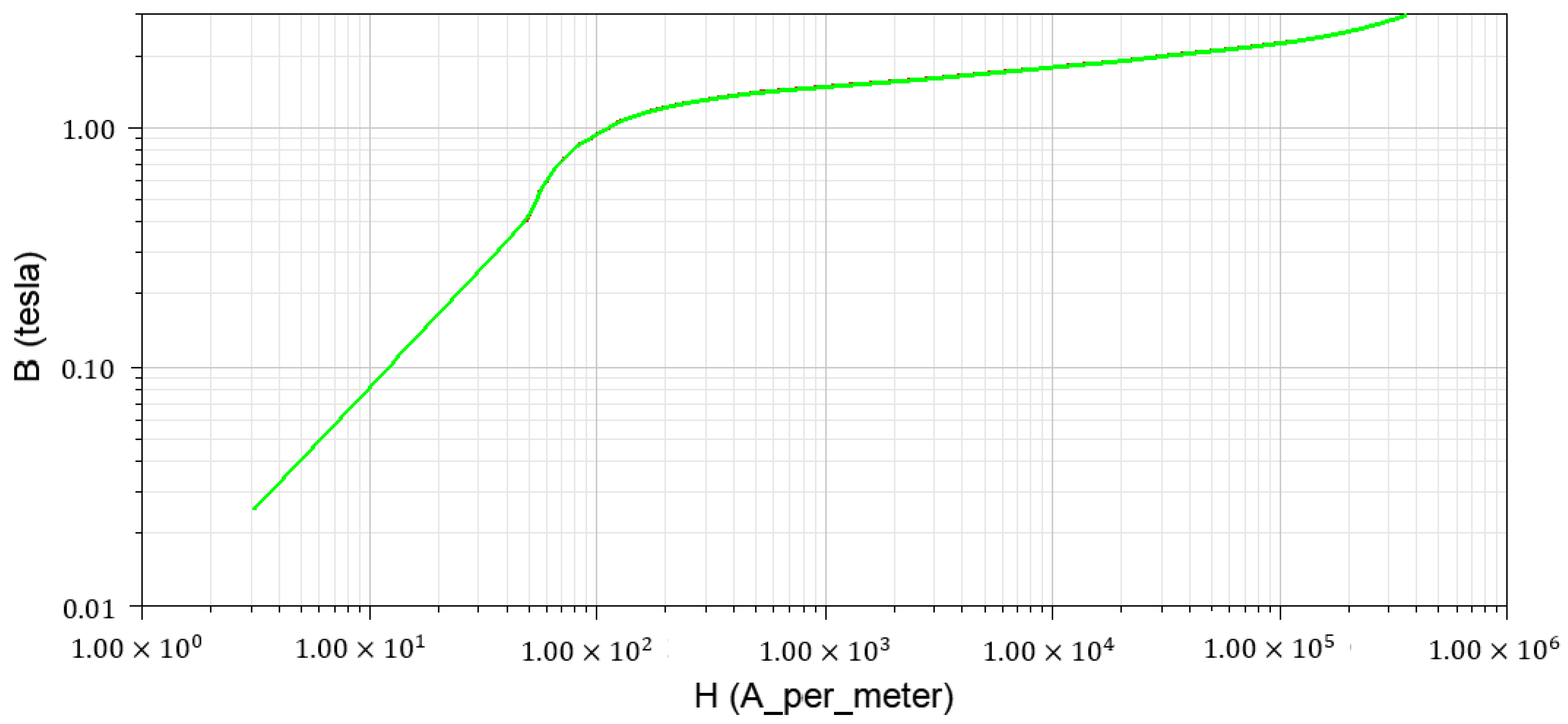



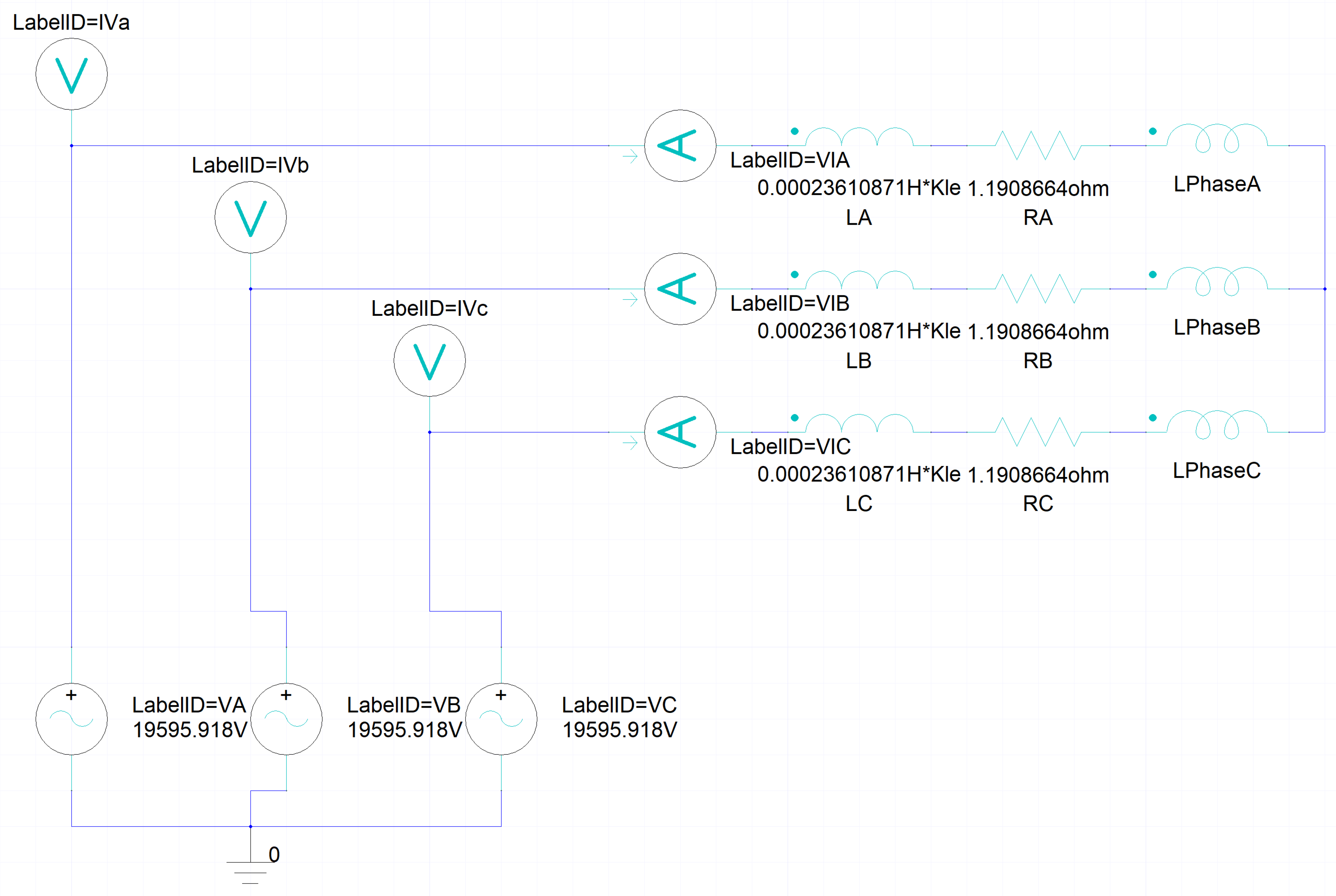


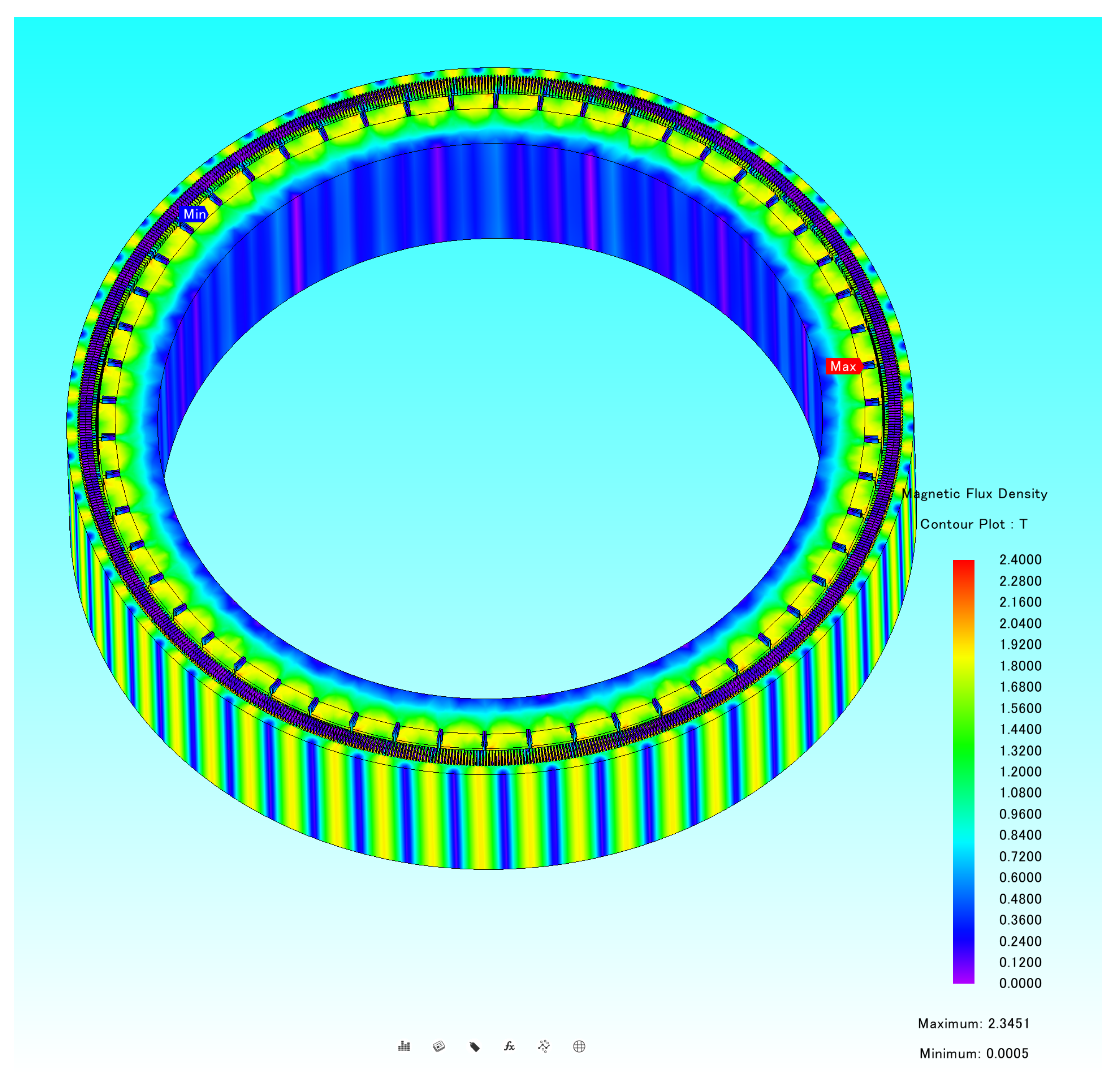

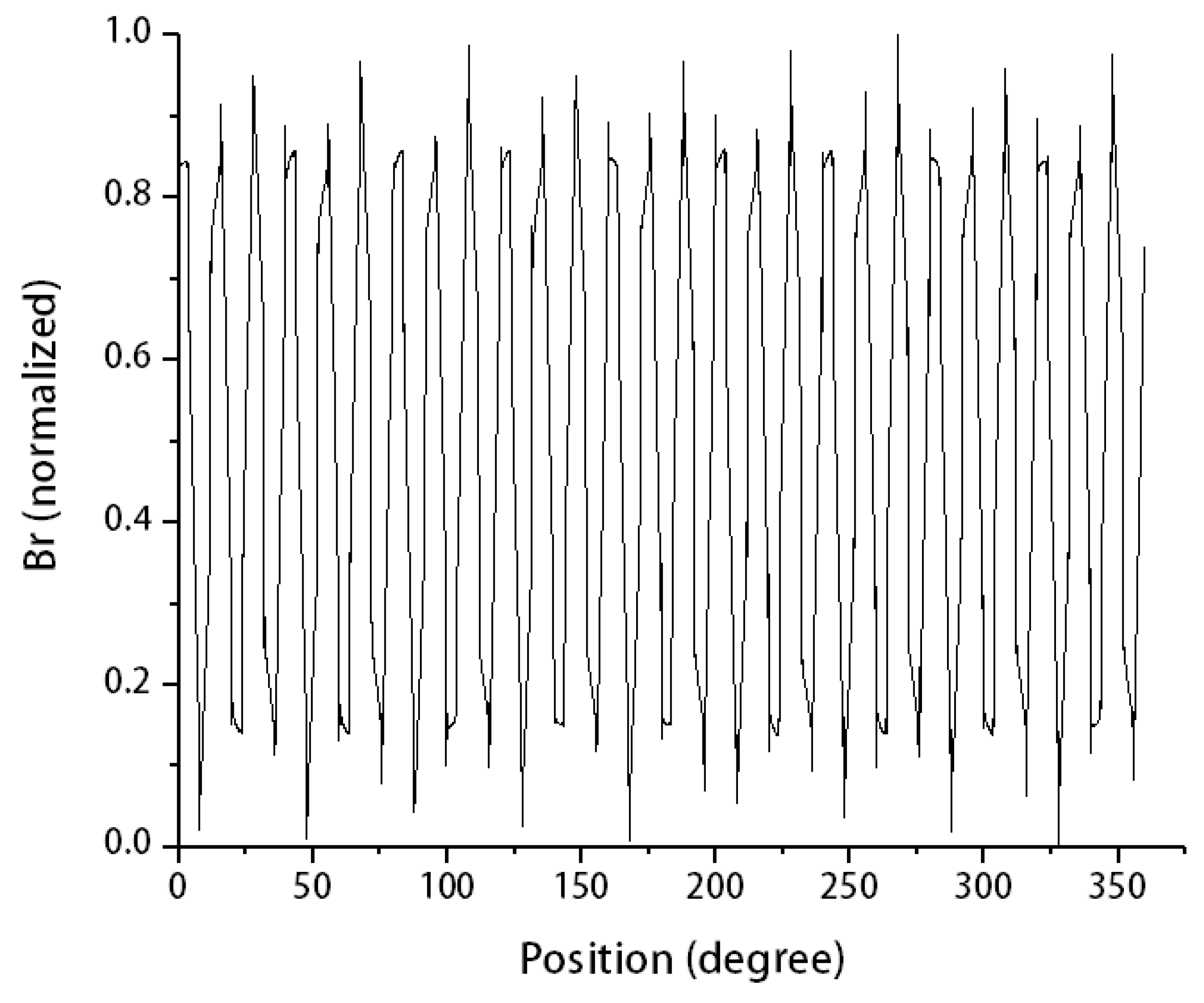

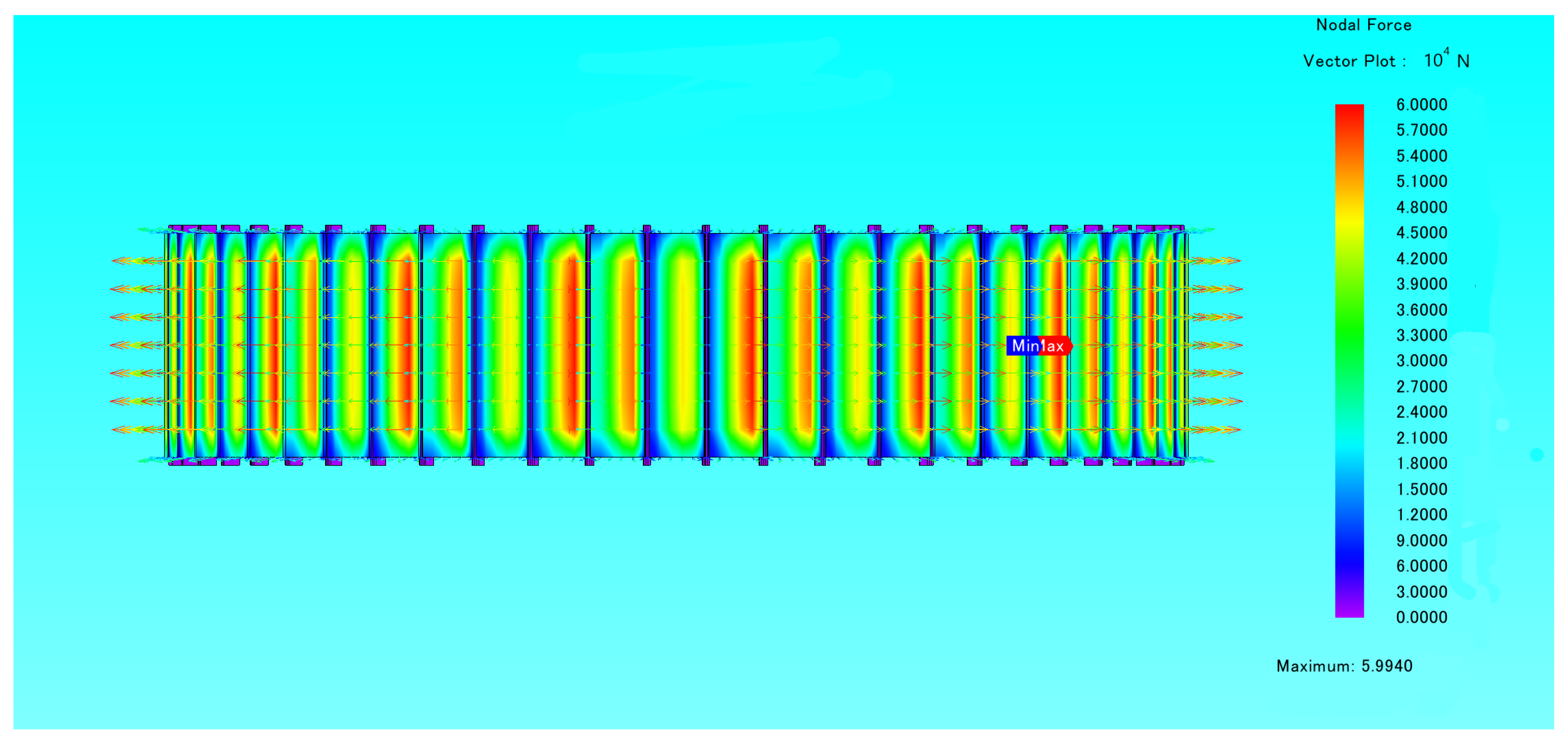


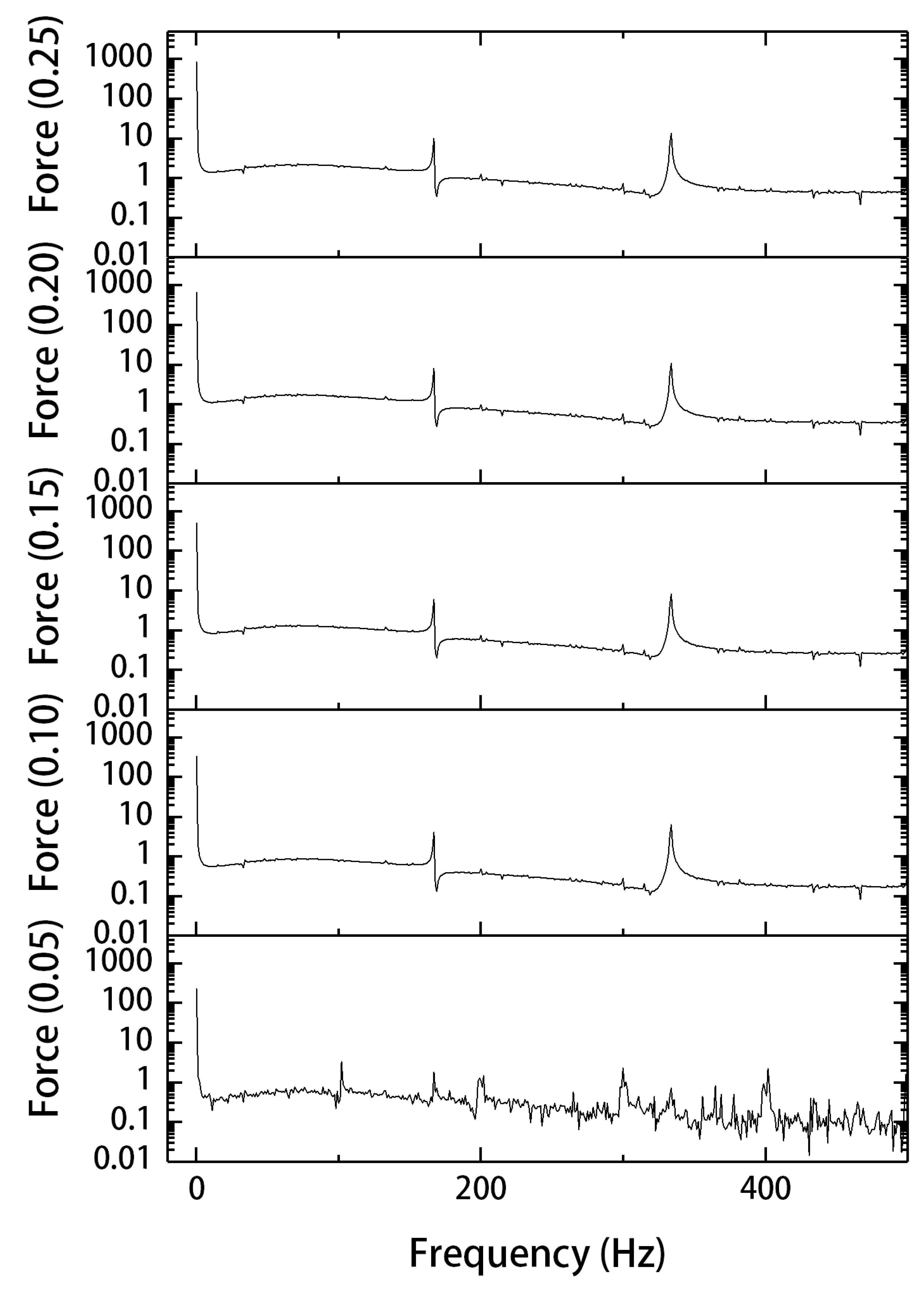


| Parameters (Units) | Values |
|---|---|
| Rated power (MW) | 1000 |
| Rated power factor | 0.9 |
| Number of poles | 54 |
| Number of slots | 810 |
| Winding connection | Wye |
| Parallel branches | 9 |
| Coil pitch | 14 |
| Frequency | 50 Hz |
| Inner diameter of the stator | 17,500 mm |
| Outer diameter of the stator | 16,300 mm |
| Aair gap thickness | 49 mm |
| The armature winding end part extension | 120 mm |
Disclaimer/Publisher’s Note: The statements, opinions and data contained in all publications are solely those of the individual author(s) and contributor(s) and not of MDPI and/or the editor(s). MDPI and/or the editor(s) disclaim responsibility for any injury to people or property resulting from any ideas, methods, instructions or products referred to in the content. |
© 2023 by the authors. Licensee MDPI, Basel, Switzerland. This article is an open access article distributed under the terms and conditions of the Creative Commons Attribution (CC BY) license (https://creativecommons.org/licenses/by/4.0/).
Share and Cite
Zhang, J.; Zhang, J.; Huang, X.; Chen, G.; Wang, Z.; You, C. Effect of Generator Rotor Radial Deviation on the Unbalanced Magnetic Pull of 1000 MW Hydro-Generator Unit. Processes 2023, 11, 899. https://doi.org/10.3390/pr11030899
Zhang J, Zhang J, Huang X, Chen G, Wang Z, You C. Effect of Generator Rotor Radial Deviation on the Unbalanced Magnetic Pull of 1000 MW Hydro-Generator Unit. Processes. 2023; 11(3):899. https://doi.org/10.3390/pr11030899
Chicago/Turabian StyleZhang, Jiwen, Jianwei Zhang, Xingxing Huang, Gaoqiang Chen, Zhengwei Wang, and Congdong You. 2023. "Effect of Generator Rotor Radial Deviation on the Unbalanced Magnetic Pull of 1000 MW Hydro-Generator Unit" Processes 11, no. 3: 899. https://doi.org/10.3390/pr11030899
APA StyleZhang, J., Zhang, J., Huang, X., Chen, G., Wang, Z., & You, C. (2023). Effect of Generator Rotor Radial Deviation on the Unbalanced Magnetic Pull of 1000 MW Hydro-Generator Unit. Processes, 11(3), 899. https://doi.org/10.3390/pr11030899








